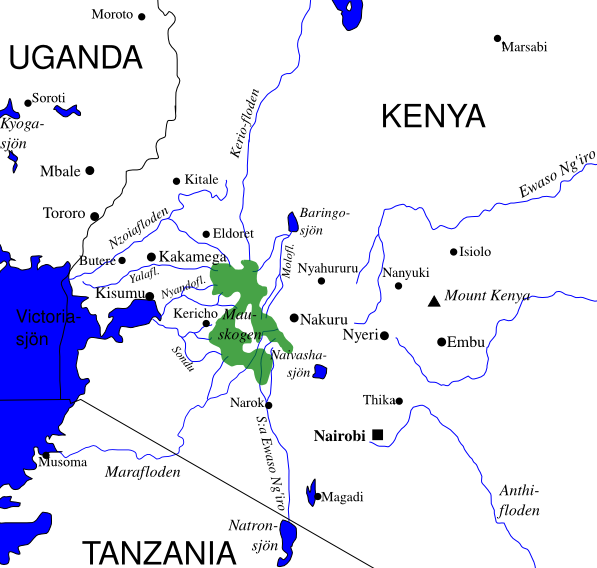Mau Forest on:
[Wikipedia]
[Google]
[Amazon]
 Mau Forest is a forest complex in the Rift Valley of Kenya. It is the largest indigenous montane forest in
Mau Forest is a forest complex in the Rift Valley of Kenya. It is the largest indigenous montane forest in
/ref> The forest area has some of the highest rainfall rates in Kenya. Mau Forest is the largest drainage basin in Kenya.Daily Nation, July 22, 2008
Selfish interests threaten Mau forest
Numerous rivers originate from the forest, including the Southern Ewaso Ng'iro,
MP vows to fight Moi eviction bid
/ref>
 Mau Forest is a forest complex in the Rift Valley of Kenya. It is the largest indigenous montane forest in
Mau Forest is a forest complex in the Rift Valley of Kenya. It is the largest indigenous montane forest in East Africa
East Africa, Eastern Africa, or East of Africa, is the eastern subregion of the African continent. In the United Nations Statistics Division scheme of geographic regions, 10-11-(16*) territories make up Eastern Africa:
Due to the historical ...
. The Mau Forest complex has an area of .BirdLife IBA Factsheet/ref> The forest area has some of the highest rainfall rates in Kenya. Mau Forest is the largest drainage basin in Kenya.Daily Nation, July 22, 2008
Selfish interests threaten Mau forest
Numerous rivers originate from the forest, including the Southern Ewaso Ng'iro,
Sondu River
Sondu is a small town border town in Kenya's Kisumu County and Kericho County.The boundary between Kisumu and Kericho counties has been contentious for years with original boundary posed to have been behind Sondu Police station which was in Ki ...
, Mara River and Njoro River. These rivers feed Lake Victoria
Lake Victoria is one of the African Great Lakes. With a surface area of approximately , Lake Victoria is Africa's largest lake by area, the world's largest tropical lake, and the world's second-largest fresh water lake by surface area after ...
, Lake Nakuru and Lake Natron. The western slopes of the Mau Escarpment are covered by the Mau Forest.
Ecology
Typical tree species in the Mau Forest include ''Pouteria adolfi-friedericii
''Pouteria adolfi-friedericii'' is a species of plant in the family Sapotaceae, a tall, tropical forest tree. It is found in Burundi, the Democratic Republic of the Congo, Ethiopia, Kenya, Malawi, Rwanda, Sudan, Tanzania, Uganda, Zambia and Zimb ...
'', ''Strombosia scheffleri
''Strombosia'' is a plant genus of about 10 species in the family Olacaceae. It has also been classified in the family Strombosiaceae. The generic name is from the Greek ', meaning "pear-shaped", referring to the fruit.
Description
''Strombosia'' ...
'' and ''Polyscias kikuyuensis
''Polyscias kikuyuensis'', also called the parasol tree and mutati, is a species of plant in the family Araliaceae. It is endemic to Kenya, where its wood is used to make boxes and similar items. The species is confined to wet upland forest, and ...
''. '' Olea capensis'', '' Prunus africana'', '' Albizia gummifera'', and '' Podocarpus milanjianus'' are also found there.
Endemic bird species in the area include Hartlaub's turaco (''Tauraco hartlaubi''), Hunter's cisticola (''Cisticola hunteri'') and Jackson's spurfowl (''Pternistis jacksoni'').
Destruction
The forest has been traditionally inhabited by Ogiek people, whosehunter-gatherer
A traditional hunter-gatherer or forager is a human living an ancestrally derived lifestyle in which most or all food is obtained by foraging, that is, by gathering food from local sources, especially edible wild plants but also insects, fungi, ...
lifestyle is sustainable. However, due to immigration from other ethnic groups, large parts of the forest area have been cleared for settlement. Human activities, especially logging
Logging is the process of cutting, processing, and moving trees to a location for transport. It may include skidding, on-site processing, and loading of trees or logs onto trucks or skeleton cars.
Logging is the beginning of a supply chain ...
, have led to deforestation of more than a quarter of the area since 1973. This is due to the increased charcoal trade in places like Narok town and the supply of logs to saw mills in Baringo, Nakuru and Narok counties.
In 2008, the inauguration of the Sondu-Miriu hydro power plant was postponed due to low water levels, that are said to be resulting from the destruction of the Mau Forest.
Mau Forest evictions
In summer 2008 there was a political row over resettlement of people, who had been allocated land there during the KANU era during the 1980s and 1990s. Some of the settlers are famed politicians, like Franklin Bett and Zakayo Cheruiyot. In 2004 Paul Ndung’u released "Ndungu Report", which listed these land allocations, terming them illegal and recommended revocation of them. Some evictions were implemented between 2004 and 2006, without a resettlement scheme. On July 15, 2008, Prime minister Raila Odinga issued an order that these evictions to be implemented by October 2008 in order to protect the forest from destruction. The order has been opposed by number of Rift Valley area politicians, led by Isaac Ruto. Some politicians, led by Minister of Agriculture William Ruto, propose that if evictions are implemented, the government should allocate them land elsewhere. The evictions began in November 2009. Some prominent people are set to lose their land, including family members of former president Daniel arap Moi. Also under threat is theKiptagich Tea Factory
Kiptagich is a settlement in Kenya
)
, national_anthem = "Ee Mungu Nguvu Yetu"()
, image_map =
, map_caption =
, image_map2 =
, capital = Nairobi
, coordinates =
, ...
owned by former president Moi.Daily Nation, December 22, 2009MP vows to fight Moi eviction bid
/ref>
References
External links
* * {{coord, 0, 36, 35, S, 35, 44, 08, E, type:forest_source:kolossus-frwiki, display=title East African montane forests Forests of Kenya